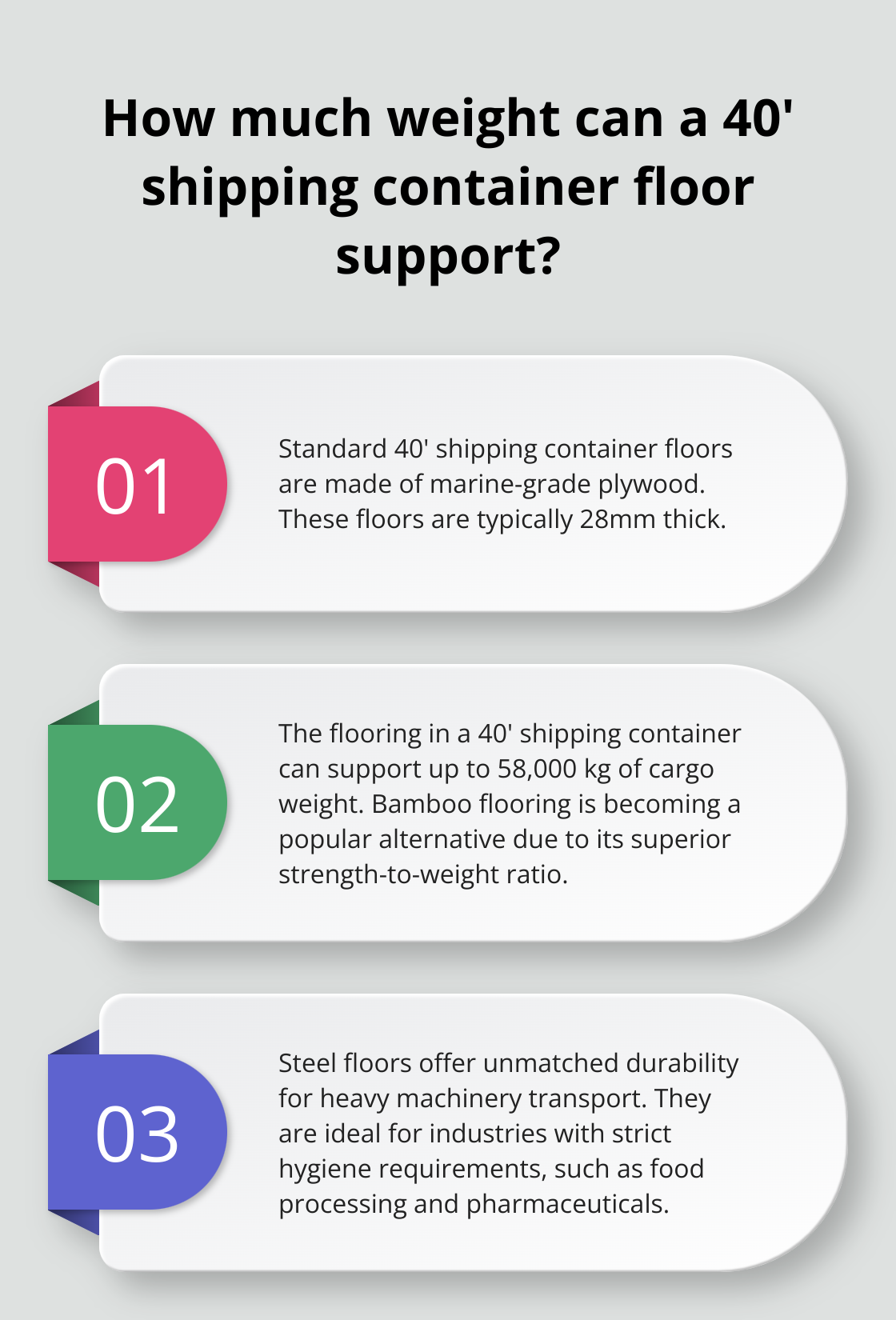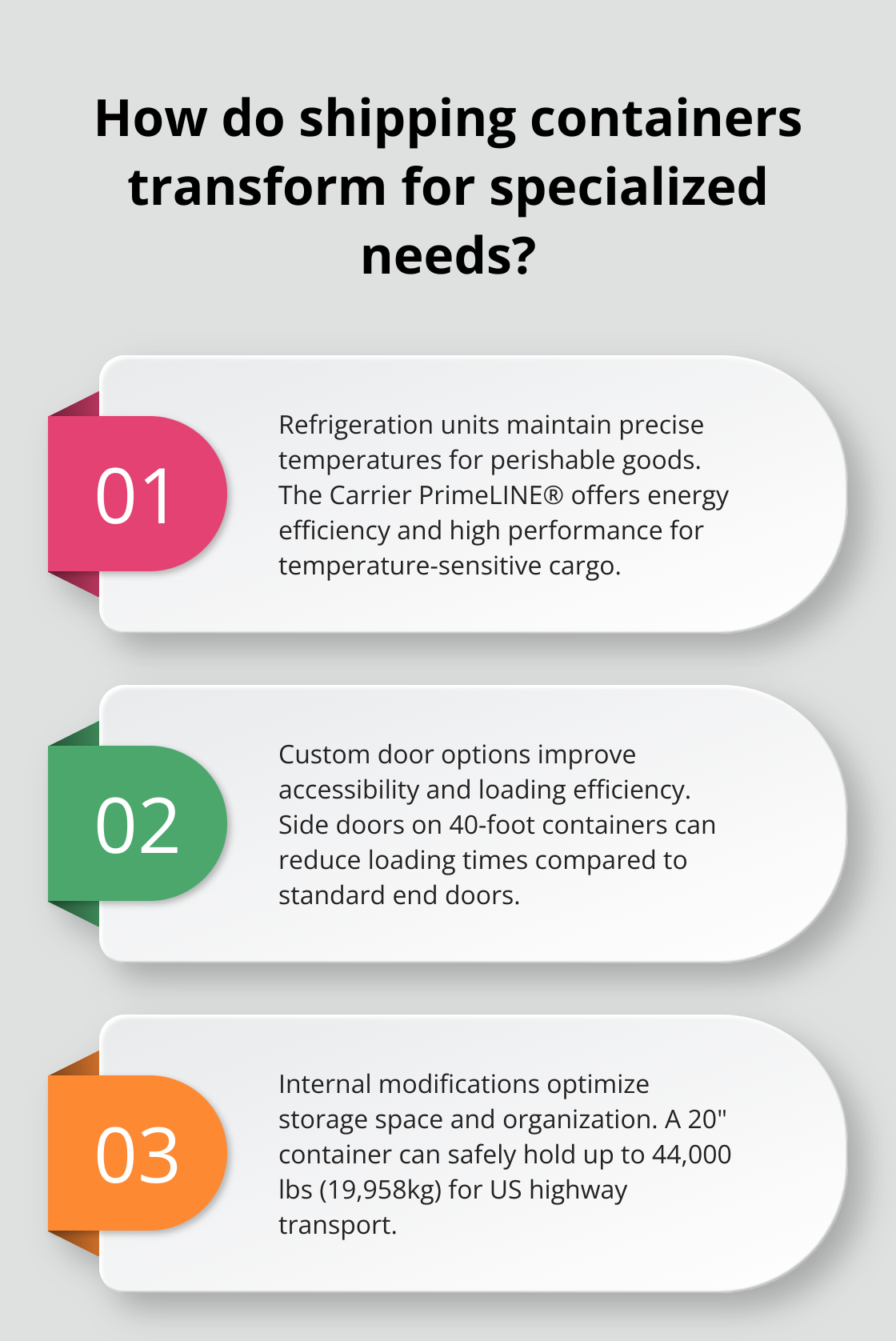
At Delta Mark, we’re diving deep into the anatomy of shipping containers. These metal giants are more complex than they appear at first glance.
Understanding the various shipping container parts and their functions is essential for anyone involved in logistics or container-based projects. Our detailed shipping container parts diagram will guide you through the key components that make these versatile structures so reliable and efficient.
What’s on the Outside of a Shipping Container?
Shipping containers are engineering marvels designed to withstand the rigors of global transport. Each exterior component plays a vital role in the container’s functionality and durability. Let’s explore these key elements that make shipping containers the backbone of international trade.
Corner Castings: The Unsung Heroes of Container Handling
Corner castings are the reinforced corners of a shipping container that enable easy lifting and securing. These steel fittings are standardized across the industry, ensuring compatibility with various handling equipment. Twist locks (locking devices that fit into the corner castings) secure containers to ships, trucks, and each other when stacked. The International Organization for Standardization (ISO) specifies the basic dimensions, functional and strength specifications for corner and intermediate fittings for series one freight containers.
Doors and Locks: Securing Cargo Across Oceans
The doors of a shipping container are more than just entry points. Engineers design them to create a watertight seal, protecting cargo from the elements. Most containers feature two doors that open outwards to 270 degrees, maximizing access for loading and unloading. The locking mechanisms (typically consisting of vertical locking bars and cam keepers) withstand attempted break-ins and the pressures of stacking. For added security, many shippers use high-security seals or padlocks. Cargo theft remains a significant issue in the marine industry, with billions lost each year. New technology is proving to be both a blessing and a curse in addressing this problem.
Walls and Roof: The Container’s Shield
Manufacturers construct the side panels and roof of a shipping container from corrugated steel, providing strength while minimizing weight. This design allows containers to be stacked up to nine high when fully loaded. The corrugation also aids in shedding water, preventing pooling on the roof. ISO standards state that a standard 20-foot container can withstand up to 192 metric tons stacked on its corner posts. This incredible strength-to-weight ratio makes container shipping highly efficient.
Identification: More Than Just Numbers
Every shipping container bears unique markings and identification plates that are essential for tracking and management. The most important is the BIC code, a standardized system developed by the Bureau International des Containers. This code consists of four letters followed by seven numbers, providing a unique identifier for each container. Additionally, containers display information about their size, type, and maximum gross weight. These markings are not just for show – they’re vital for efficient logistics operations and compliance with international shipping regulations.

As we move from the exterior to the interior of shipping containers, we’ll discover how the internal features complement these robust external components to create a versatile and reliable transport solution.
Inside the Box: Efficient Container Interiors
Flooring: The Cargo’s Foundation
The floor of a shipping container serves as its unsung hero. Marine-grade plywood forms the standard flooring material in 40′ shipping containers, engineered to withstand heavy loads and resist moisture and decay. These floors typically measure 28mm in thickness and support up to 58,000 kg of cargo weight. A recent trend shows a shift towards bamboo flooring, which offers a superior strength-to-weight ratio and enhanced resistance to pests and mold.

For industries handling heavy machinery or equipment, steel floors provide unmatched durability. While more expensive, they offer easier cleaning, making them ideal for sectors with strict hygiene requirements (such as food processing or pharmaceutical transport).
Insulation: Temperature Control in Transit
Insulation plays a vital role for temperature-sensitive cargo. Spray foam insulation remains popular due to its excellent R-value and ability to conform to the container’s corrugated walls. An eco-friendly alternative, recycled denim insulation, has gained traction. This non-toxic option provides effective temperature regulation and easy installation.
Reefer containers utilize polyurethane foam insulation as standard. Manufacturers inject this material between the container’s outer steel and inner aluminum walls, creating an airtight seal to maintain precise temperatures for perishable goods.
Ventilation: Airflow Management
Proper airflow prevents condensation and protects cargo from moisture damage. Standard containers feature small vents near the top corners, but these often prove insufficient for many cargo types. Additional vents or small solar-powered fans significantly improve air circulation.
Containers used in hot climates benefit from roof-mounted turbine vents. These passive systems harness wind power to expel hot air from the container, maintaining a cooler interior without energy costs.
Cargo Securing: Safety in Transit
A container’s interior requires proper cargo securing points. D-rings welded to the floor or walls provide anchor points for straps and chains. For versatility, logistics tracks along the walls allow for adjustable tie-down points and can support shelving systems for organized storage.
Effective cargo securing relies on even load distribution. Use appropriate lashing equipment and consider container lashing bars in addition to straps for valuable or heavy cargo.
The interior design of a shipping container determines its efficiency and versatility as a cargo solution. As we move forward, we’ll explore how specialized modifications and add-ons further enhance these steel giants, transforming them into customized transport solutions for diverse industries.
How to Customize Shipping Containers for Specialized Needs
Shipping containers offer versatile solutions beyond basic cargo transport. With the right modifications, these steel boxes transform into customized assets for diverse industries. Let’s explore some key customization options that enhance container functionality.
Refrigeration Units: Precision Temperature Control
Reefer containers play a vital role in transporting temperature-sensitive goods. These specialized units include built-in refrigeration systems that maintain precise temperatures. The Carrier PrimeLINE® is designed for world-class performance when it comes to energy efficiency, capacity, and lifecycle cost. This type of unit preserves perishable goods during long transit times.

Power consumption is a key factor when selecting a reefer container. Modern units use less energy than older models, which reduces operating costs significantly. For high-value temperature-sensitive products (such as pharmaceuticals), containers with redundant cooling systems provide extra protection against equipment failure.
Custom Door Options: Improved Accessibility
Standard end doors don’t always offer the most efficient option for every cargo type. Side doors and roll-up doors can improve loading and unloading times dramatically. A 40-foot container with a full-length side door allows forklifts to access the entire container length simultaneously, potentially cutting loading times compared to end-loading.
Roll-up doors work particularly well for containers used in retail or event settings. These doors provide a clean, professional look and secure easily with minimal space requirements. When selecting roll-up doors, heavy-duty models with weather-resistant seals maintain the container’s integrity against the elements.
Storage Solutions: Space Optimization
Internal modifications turn a basic container into a highly organized storage unit. Adjustable shelving systems can increase usable space compared to floor-stacked cargo. Weight distribution requires careful consideration when implementing shelving. In a 20″ container, up to 44,000 lbs (19,958kg) can be safely and legally loaded for highway transport in the US.
Drawer systems offer an excellent solution for businesses dealing with small parts or tools. Industrial-grade drawer units provide easy access to items without sacrificing floor space. Some companies report inventory management efficiency improvements after implementing these systems.
Lighting and Electrical: Power Integration
Proper lighting ensures safety and efficiency in container operations. LED lighting strips prove popular due to their low energy consumption and long lifespan. This low power draw matters particularly for off-grid applications or when running on generator power.
Marine-grade components withstand the harsh conditions containers often face when installing electrical systems. GFCI outlets enhance safety, especially in damp environments. For containers that require constant power (such as remote offices or data centers), solar panels with battery backup systems provide a reliable solution. A solar system with a battery can power basic operations, reducing or eliminating the need for grid connection.
These customizations significantly enhance shipping container functionality, creating versatile assets for businesses across various industries. As container technology evolves, innovative solutions continue to meet diverse client needs.
Final Thoughts
A shipping container parts diagram helps professionals make informed decisions about container selection, maintenance, and modifications. The standardized design of shipping containers impacts global trade efficiency by ensuring seamless intermodal transport and reducing handling times and costs. Advanced locking mechanisms and security features protect cargo during transit, while specialized modifications cater to diverse industry needs.

The future of container innovation includes trends towards sustainable materials and smart container technology with IoT sensors for real-time tracking. Advancements in refrigeration units improve energy efficiency and temperature control precision. As global trade evolves, container designs will adapt to meet new challenges and opportunities.
We at Delta Mark provide high-quality container solutions that meet the diverse needs of our clients. Our range of products includes new and used ISO containers, specialized parts, and accessories. The shipping container, with its seemingly simple design, continues to be a marvel of engineering that underpins global commerce.
